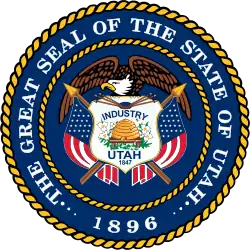Wayne County, Utah
Wayne County is a county in the U.S. state of Utah. As of the 2010 census, the population was 2,778,[1] making it the fourth-least populous county in Utah. Its county seat is Loa.[2]
Wayne County | |
|---|---|
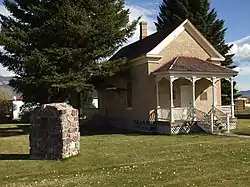 | |
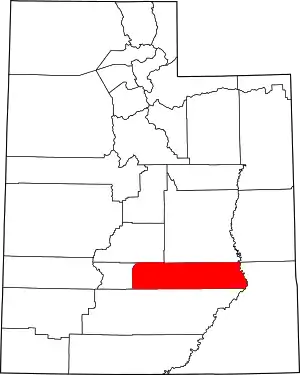 Location within the U.S. state of Utah | |
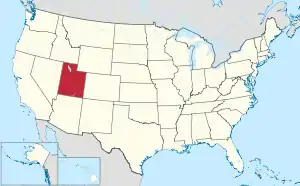 Utah's location within the U.S. | |
| Coordinates: 38°22′N 110°54′W | |
| Country | |
| State | |
| Founded | March 10, 1892 |
| Named for | Wayne County, Tennessee |
| Seat | Loa |
| Largest town | Loa |
| Area | |
| • Total | 2,466 sq mi (6,390 km2) |
| • Land | 2,461 sq mi (6,370 km2) |
| • Water | 5.8 sq mi (15 km2) 0.2% |
| Population (2010) | |
| • Total | 2,778 |
| • Estimate (2019) | 2,711 |
| • Density | 1.1/sq mi (0.4/km2) |
| Time zone | UTC−7 (Mountain) |
| • Summer (DST) | UTC−6 (MDT) |
| Congressional district | 2nd |
| Website | www |
History
Due to its remoteness and harsh terrain, settlements did not appear in the future Wayne County until the 1880s. By 1892, there was enough settlement and enough interest in a separate county (due mainly to the difficulty of accessing the Piute County seat), that Utah Territory passed an act (effective date March 10, 1892)[3] to separate the east portion of Piute into a separate county.[4] The county was named for Wayne County, Tennessee, itself named for Anthony Wayne.[5] The county boundaries have remained unchanged since its creation.
Geography
The eastern border of Wayne County is delineated by the meanders of the Green River, which flows southward to discharge into the Colorado River. After the two rivers join, the combined southwestern flow forms the remaining portion of the county's east border. The central part of the county is drained by the Fremont River and Muddy Creek. The Fremont begins at Fish Lake in Sevier County and flows into Wayne County near its northwestern corner. It joins the Muddy near Hanksville to form the Dirty Devil River, which flows southeastward out of the county's south border to discharge into the Colorado. Wayne County terrain varies from rough forestland on the west, to arid poor soil carved by drainages and rocky outcrops.[6] The terrain slopes to the east and south; its highest area is near its NW corner, at 9,888' (3014m) ASL.[7] The county has a total area of 2,466 square miles (6,390 km2), of which 2,461 square miles (6,370 km2) is land and 5.8 square miles (15 km2) (0.2%) is water.[8]
The Green River, passing through the canyons of Canyonlands National Park, forms the eastern boundary. The San Rafael Desert occupies the center of the county. Thousand Lake Mountain and Boulder Mountain flank Rabbit Valley on the western end of the county, where beautiful forests contrast with the deserts to the east. The small population of the county is centered in Rabbit Valley, with one town of 200, Hanksville, located in Graves Valley north of the Henry Mountains. Wayne County is also home of Capitol Reef National Park.
Adjacent counties
- Emery County - north
- Grand County - northeast
- San Juan County - east
- Garfield County - south
- Piute County - west
- Sevier County (northwest)
National Parks
Lakes
- Mill Meadow Reservoir (part)[6]
Demographics
| Historical population | |||
|---|---|---|---|
| Census | Pop. | %± | |
| 1900 | 1,907 | — | |
| 1910 | 1,749 | −8.3% | |
| 1920 | 2,097 | 19.9% | |
| 1930 | 2,067 | −1.4% | |
| 1940 | 2,394 | 15.8% | |
| 1950 | 2,205 | −7.9% | |
| 1960 | 1,728 | −21.6% | |
| 1970 | 1,483 | −14.2% | |
| 1980 | 1,911 | 28.9% | |
| 1990 | 2,177 | 13.9% | |
| 2000 | 2,509 | 15.3% | |
| 2010 | 2,778 | 10.7% | |
| 2019 (est.) | 2,711 | −2.4% | |
| US Decennial Census[9] 1790–1960[10] 1900–1990[11] 1990–2000[12] 2010–2018[1] 2019[13] | |||
2000 census
As of the 2000 United States Census, there were 2,509 people, 890 households, and 669 families in the county. The population density was 1.02/sqmi (0.39/km2). There were 1,329 housing units at an average density of 0.54/sqmi (0.21/km2). The racial makeup of the county was 97.29% White, 0.16% Black or African American, 0.36% Native American, 0.08% Asian, 0.16% Pacific Islander, 1.24% from other races, and 0.72% from two or more races. 1.99% of the population were Hispanic or Latino of any race.
There were 890 households, out of which 36.20% had children under the age of 18 living with them, 66.50% were married couples living together, 5.30% had a female householder with no husband present, and 24.80% were non-families. 21.50% of all households were made up of individuals, and 9.60% had someone living alone who was 65 years of age or older. The average household size was 2.81 and the average family size was 3.31.
The county population contained 32.40% under the age of 18, 8.10% from 18 to 24, 22.50% from 25 to 44, 22.60% from 45 to 64, and 14.40% who were 65 years of age or older. The median age was 34 years. For every 100 females there were 103.50 males. For every 100 females age 18 and over, there were 103.50 males.
The median income for a household in the county was $32,000, and the median income for a family was $36,940. Males had a median income of $26,645 versus $20,000 for females. The per capita income for the county was $15,392. About 12.70% of families and 15.40% of the population were below the poverty line, including 22.10% of those under age 18 and 8.20% of those age 65 or over.
Communities
Towns
- Bicknell
- Hanksville
- Loa (county seat)
- Lyman
- Torrey
Unincorporated communities
- Caineville
- Fruita
- Grover
- Notom
Former communities
- Aldridge
- Eagle City
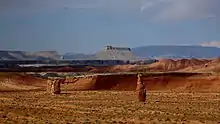
Politics
Wayne County voters are traditionally Republican. In only one national election since 1948 has the county selected the Democratic Party candidate (as of 2016).
| Year | Republican | Democratic | Third parties |
|---|---|---|---|
| 2016 | 67.7% 966 | 19.0% 271 | 13.3% 189 |
| 2012 | 82.1% 1,089 | 16.2% 215 | 1.7% 23 |
| 2008 | 70.0% 940 | 25.0% 335 | 5.0% 67 |
| 2004 | 78.1% 1,062 | 20.5% 279 | 1.4% 19 |
| 2000 | 77.8% 953 | 16.5% 202 | 5.7% 70 |
| 1996 | 64.9% 741 | 23.2% 265 | 11.9% 136 |
| 1992 | 57.6% 706 | 19.3% 236 | 23.1% 283 |
| 1988 | 68.6% 784 | 30.9% 353 | 0.5% 6 |
| 1984 | 80.2% 930 | 19.3% 224 | 0.4% 5 |
| 1980 | 76.1% 835 | 20.6% 226 | 3.4% 37 |
| 1976 | 59.1% 555 | 35.6% 334 | 5.3% 50 |
| 1972 | 71.8% 597 | 22.0% 183 | 6.3% 52 |
| 1968 | 62.9% 511 | 30.5% 248 | 6.6% 54 |
| 1964 | 49.3% 400 | 50.7% 412 | |
| 1960 | 53.9% 446 | 46.1% 382 | |
| 1956 | 63.8% 499 | 36.2% 283 | |
| 1952 | 66.1% 536 | 33.9% 275 | |
| 1948 | 44.2% 367 | 55.4% 460 | 0.5% 4 |
| 1944 | 43.1% 325 | 57.0% 430 | |
| 1940 | 43.1% 380 | 56.8% 500 | 0.1% 1 |
| 1936 | 38.5% 329 | 61.1% 522 | 0.4% 3 |
| 1932 | 49.3% 398 | 49.6% 401 | 1.1% 9 |
| 1928 | 68.2% 422 | 31.5% 195 | 0.3% 2 |
| 1924 | 57.3% 331 | 41.7% 241 | 1.0% 6 |
| 1920 | 62.0% 396 | 35.1% 224 | 3.0% 19 |
| 1916 | 35.9% 225 | 62.7% 393 | 1.4% 9 |
| 1912 | 52.0% 282 | 33.8% 183 | 14.2% 77 |
| 1908 | 49.9% 279 | 32.9% 184 | 17.2% 96 |
| 1904 | 53.3% 310 | 43.1% 251 | 3.6% 21 |
| 1900 | 52.9% 324 | 46.1% 282 | 1.0% 6 |
| 1896 | 16.2% 78 | 83.9% 405 |
See also
- National Register of Historic Places listings in Wayne County, Utah
- For additional History of Wayne County Utah see "Utah's Stolen Treasures" by Gene Covington ISBN 978-1-62516-335-6 (e-book) or ISBN 978-1-61897-954-4 (paperback)
References
- "State & County QuickFacts". United States Census Bureau. Archived from the original on September 5, 2015. Retrieved December 30, 2013.
- "Find a County". National Association of Counties. Retrieved June 7, 2011.
- Newberry Library. Individual County Chronologies - Wayne County UT (accessed March 25, 2019)
- ""History". This narrative says the county was established in May 1892 (possibly referring to the date its government was organized). Wayne County website (accessed 25 March 2019)". Archived from the original on March 24, 2019. Retrieved March 24, 2019.
- Murphy, Miriam B. (January 1999). A History of Wayne County (PDF). Utah Centennial County History Series. Salt Lake City: Utah State Historical Society. pp. 78–80. ISBN 0-913738-45-X. Retrieved January 27, 2015.
- Wayne County UT Google Maps (accessed 24 March 2019)
- ""Find an Altitude/Wayne County UT" Google Maps (accessed 24 March 2019)". Archived from the original on May 21, 2019. Retrieved March 24, 2019.
- "2010 Census Gazetteer Files". US Census Bureau. August 22, 2012. Retrieved June 26, 2015.
- "US Decennial Census". US Census Bureau. Retrieved June 26, 2015.
- "Historical Census Browser". University of Virginia Library. Retrieved June 26, 2015.
- Forstall, Richard L., ed. (March 27, 1995). "Population of Counties by Decennial Census: 1900 to 1990". US Census Bureau. Retrieved June 26, 2015.
- "Census 2000 PHC-T-4. Ranking Tables for Counties: 1990 and 2000" (PDF). US Census Bureau. April 2, 2001. Retrieved June 26, 2015.
- "QuickFacts. Utah counties". Retrieved May 17, 2020.
- Leip, David. "Atlas of US Presidential Elections". uselectionatlas.org. Retrieved March 31, 2018.

